#DS9 has the same 90s lighting and aspect ratios
Photo
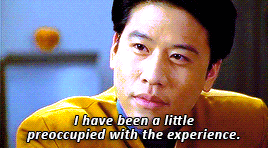


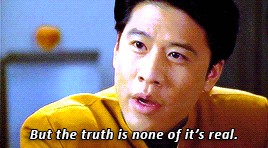
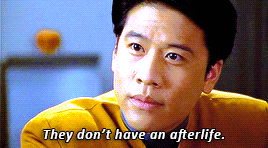
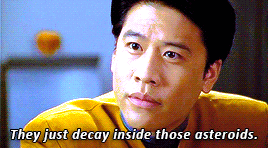
One Harry Kim Scene per Season » Season 1, Emanations
[as picked by @official-harry-kim]
#Harry Kim#Garrett Wang#Star Trek: Voyager#Star Trek VOY#type: gif#sub.type: Of The Chief#category: Star Trek#sub.category: Star Trek: Voyager#character: Harry Kim#*mygifs#*trekedit#*VOYedit#*harrypalooza#why is colouring Voyager so dfficult#DS9 has the same 90s lighting and aspect ratios#but it didn't give me nearly as much trouble#The only scenes I can do well are ones taking place in medbay
188 notes
·
View notes
Text
Star Trek Disco Prologue
CBS will air Season 1 of Star Trek: Discovery starting this Thursday at 10/9c.
Before the season begins, a Tribble Triple Feature! Each of these episodes are available on Netflix, Hulu, or CBS All Access. Probably Amazon too, but I didn’t check ‘cause truly is there anything less utopian than Amazon?
TOS 2x15 “The Trouble with Tribbles”
TAS 1x05 “More Tribbles, More Troubles”
DS9 5x06 “Trials and Tribble-ations”
Star Trek launched in September 1966. Writer Gene Roddenberry had pitched the series as a western set in outer space. But he also wanted to comment upon current events, like war and sex and religion, without attracting the ire of network censors. Season 2′s “The Trouble with Tribbles” lays out a lot of the core ideals of Star Trek that carry over the decades.

The characters hail from different backgrounds, collaborating to solve big problems — in this case, an ecological crisis. Despite their varied perspectives, they share camaraderie, respect, and a surprising amount of snark. They’re also very competent, but that doesn’t prevent disasters from happening, or the crew from simply making mistakes. This isn’t a show about space. This is a show about people who work in space.
And the people out there aren’t all friendly. We meet some adversarial aliens, namely the Klingons. We’re told they’re ferocious, brutal warriors — but Koloth actually seems quite cordial and crafty, less like a warrior and more like a spy. Rather than wage open war, they genetically modify one of their own to appear human. Which is pretty silly, ‘cause the budget constraints of the ’60s mean that Klingons already look human! These aliens seem remarkably familiar and accessible. The far more frustrating adversaries are self-important administrators like Nils Barris, or destructive capitalists like Cyrano Jones.
Star Trek features flawed heroes, frustrating villains... and a lot of moralizing. Uhura advocates on behalf of the tribbles, saying they’re “the only love money can buy.” Kirk retorts, “Too much of anything, even love, isn’t necessarily a good thing.” The bold colors and witty quips can make the morals feel reductive, even cartoonish. But for me, that’s kind of the point. Star Trek presents ethics and philosophy in a simple, accessible way. I won’t claim they’re right 100% of the time, and some of its attitudes shift over the decades — but even this early on, Star Trek stands for harmony, cooperation, and inclusion. And those are perspectives that should be cartoonishly simple.
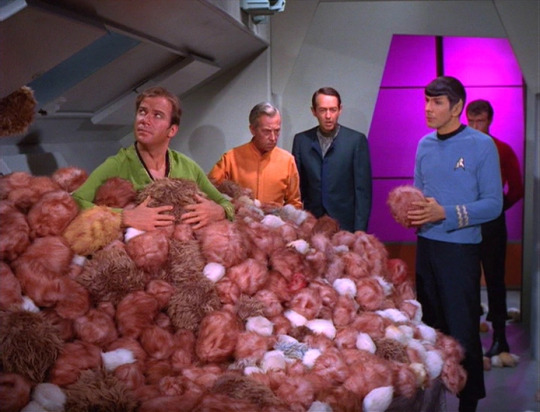
Speaking of cartoons, I took a swing with “More Tribbles, More Troubles.” I’m curious how people feel about the pacing and the primitive animation. This is one of the funnier and more action-packed episodes of The Animated Series. If folks tell me they struggled with it, I’ll cut the remaining handful of cartoons from the schedule.
I’m tickled that they bring Cyrano Jones and Koloth back; and that writer David Gerrold returns, building upon the tribbles’ previous ecological threat by introducing an ineffective predator, the glommer. I also just really enjoy the gag of Kirk repeatedly shoving an ever-growing tribble out of his chair.
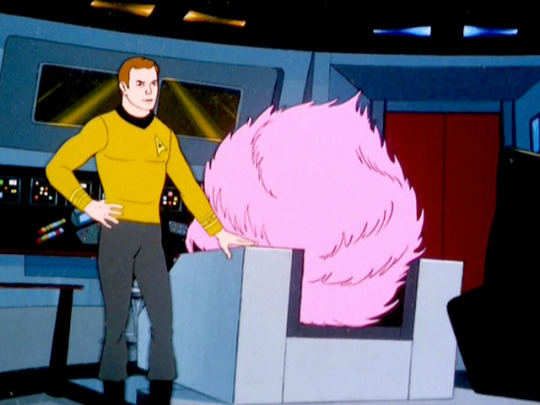
Once again, the Klingons are up to crafty business, slowing down the Enterprise with an immobilizing ray and targeting some drone ships. We see more space combat than we did in live action, but it’s still more strategic than open warfare. And again, I suspect it’s a budget issue — the recycled shots of photon torpedoes suggest more action would’ve been too expensive. The result is that the Klingons just don’t seem that ferocious yet. Ultimately Koloth doesn’t even want to punish Cyrano Jones, he just wants his useless science experiment back.
So let’s see how the Klingons change over the decades! Thirty years after the original series, Deep Space Nine uses time travel to explore Star Trek’s history. “Trials and Tribble-ations” was a 30th anniversary celebration for Star Trek, utilizing the same technology that inserted Tom Hanks into historical footage for Forrest Gump.

Integrating two versions of Star Trek across time poses some aesthetic and continuity challenges.
The Klingons of ’90s Star Trek have a much more elaborate make-up design — forehead ridges, wigs, sharpened teeth, etc. They also act more ferocious than the old Klingons. So when 24th-century Klingon Worf shares the screen with the budget-constrained 23rd-century Klingons, fan culture almost demands an explanation. This anniversary episode obliges with a throwaway joke: “It is a long story, and we do not discuss it with outsiders.”
Not every aspect of style needs an onscreen explanation. “Trials and Tribble-ations” was lucky that its visual style adapted so well to the classic series. TOS (The Original Series) and DS9 both used a square 1:33:1 aspect ratio, ’cause that was the shape of everyone’s TV. The DS9 production crew built retro sets, mimicked the same lighting, and were able to insert their actors into the original shots.

This technique is no longer possible, because the technology we use to make TV has changed so much. Even the shape of the frame is different -- we’ve all got widescreen TVs now. If 21st century Trek wants to revisit its past, it must fundamentally re-conceive how those spaces are constructed, lit, and framed.
In 1996, Star Trek was free to engage with nostalgia, caressing its old tricorders and uniforms, admiring it old performances and sets, even reliving the same story points. There’s a certain degree of pleasure and comfort to this, but it makes me a little nervous.
Roddenberry intended for Star Trek to comment upon the world we live in. While “The Trouble with Tribbles” is a comedy about ecological dangers, “Trials and Tribble-ations” is simply a comedy about old Star Trek. It’s a much more limited perspective. And it’s a limited perspective that’s broadly affected pop culture for the past twenty years.
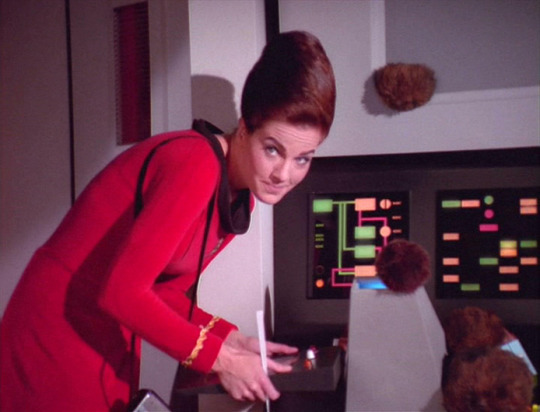
Since 2000, we’ve seen a huge rise in reboots and origin stories. (eg. Batman Begins, Casino Royale, Battlestar Galactica, Man of Steel, etc.) We usually hear that studios only trust audiences to pay for something familiar. I’d like to frame it more charitably and say, in the wake of 9/11, we’re collectively reviewing the stories that defined our culture and deciding which values and lessons are still relevant to us. Star Trek did this too.
In 2001, we got the prequel series Enterprise. 100 years before Kirk and Spock, it follows a pioneer crew on an experimental ship called Enterprise. Season 2 invokes 9/11 when an alien attack destroys Florida, and the grieving crew embark on a mission of vengeance. It was a way to comment on the invasion of Afghanistan. By season 4, the current events commentary was replaced by stories to revisit Star Trek’s lore, including a two-parter to explain Worf’s throwaway joke in “Trials and Tribble-ations” about Klingon appearances.
After Enterprise ended, we got the J.J. Abrams reboot movies, which tell an alternate origin story for Kirk and his classic crew. In the 2009 movie, an alien attack destroys the planet Vulcan, and a grieving Spock seeks vengeance. He’s still grieving in Into Darkness, but gets distracted by a character from Star Trek’s past...
If all Star Trek can do is comment upon itself, it’s no longer serving its purpose. Star Trek must be aware of the cultural, economic, and political challenges we face, and it needs to offer a vision for how we could overcome them.

We’re about to begin Star Trek: Discovery, a show drenched with contemporary awareness and semiotic significance. It takes place 90 years after Enterprise, 10 years before Kirk, and therefore has a peculiar relationship with time — both within its story, and within our world beyond the show. Discovery is Star Trek finally breaking free of its origins and serving the purpose Trek should: envisioning a way forward into a utopian future where there’s space and freedom for us all.
#star trek#star trek discovery#star trek disco#star trek dsc#tos#ds9#tribbles#the trouble with tribbles#more tribbles more troubles#trials and tribble-ations#kirk#spock#mccoy#uhura#sisko#jadzia#cyrano jones#klingon#time travel#roddenberry#mycelial mondays
8 notes
·
View notes